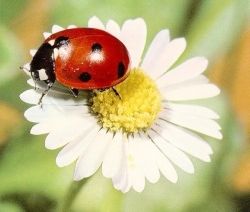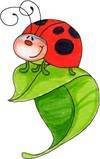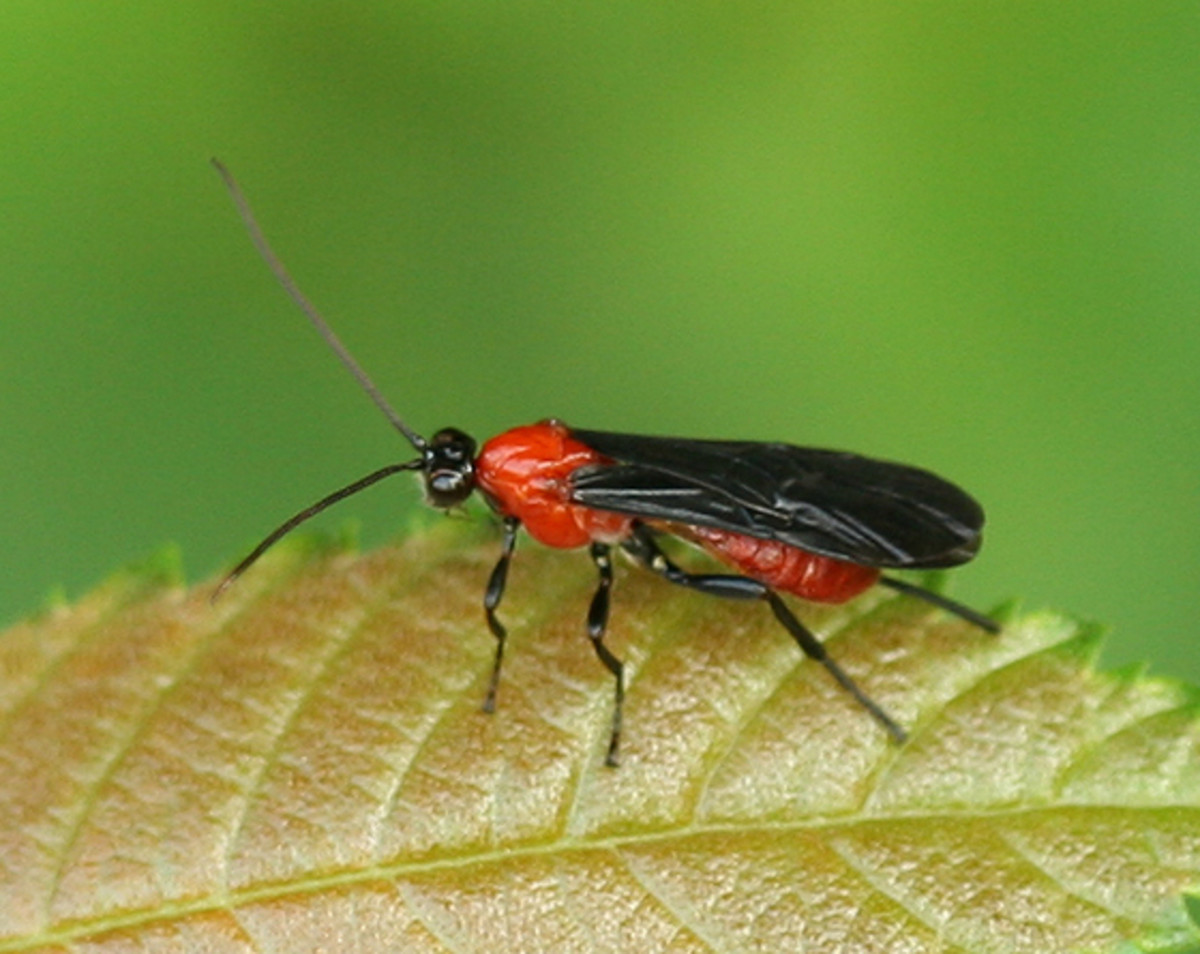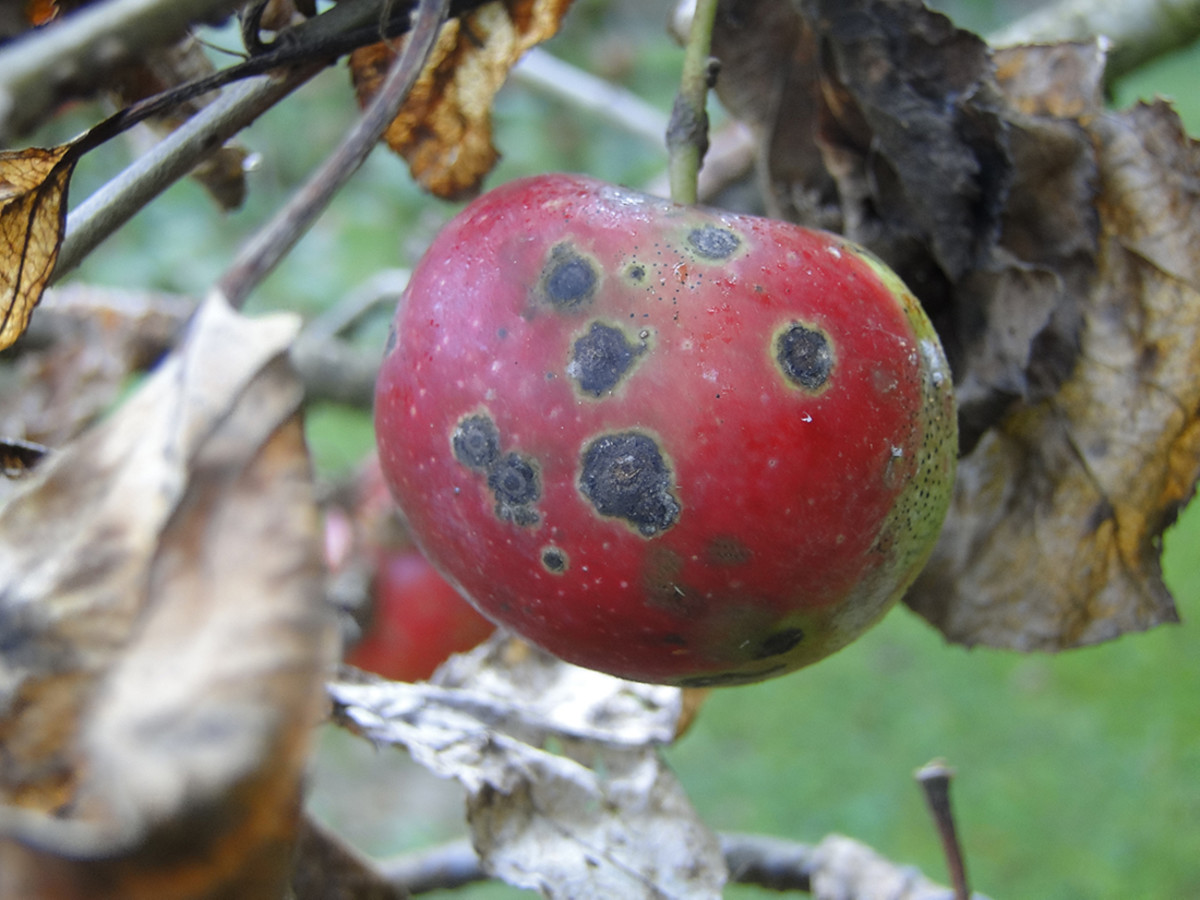Ladybugs in the garden

Ladybugs are so likeable and delightful.
Ladybugs are the favorite insects of children because of their distinctive spots and vibrant colors. Farmers love them because of their voracious appetite for plant-eating pests such as aphids, scale insects and mealybugs which destroy crops. Designers and artists are inspired by them because ladybugs are colorful and are the cutest insects around. Furthermore, ladybugs are not poisonous to humans and will not destroy homes.They secrete a bad-tasting fluid when attacked by predators and their brightly colored bodies make them undesirable preys. Ladybugs are also believed to bring good luck. So, what is there not to like about ladybugs?
Origin of the name Ladybug
Do not be fooled by the name.
Ladybugs, or Ladybirds as the names suggest, are not actually bugs or birds but belong to the family of beetles. Not all ladybugs are "ladies." There are both male and female ladybugs. The ladybug scientific name Coccinellidae literally means a small red sphere in Latin, although ladybugs are found in a variety of colors, ranging from yellow, orange, maroon, and scarlet. Some ladybugs are completely black, with bright red spots on their wings.
Another name for ladybugs is coleoptera, that means sheath winged. So how did the ladybugs get their name?
In the Middle Ages, these insects were named after the Virgin Mary, who was often shown wearing a red cloak in many paintings and were popularly known as the 'Beetle of Our Lady'. The seven black spots on the wings of the ladybugs were said to represent the seven joys and seven sorrows of Mother Mary. The name 'Beetle of Our Lady' was eventually shortened to 'ladybug'. Other names by which the ladybugs are known are 'ladybird beetles' or 'lady beetles', 'lady cow' and 'lady fly'.
Let's get scientific.
Facts about the Ladybug
Kingdom: Animalia
Phylum: Arthropoda
Class: Insecta
Order: Coleoptera
Genus: Coccinella
Family: Coccinellidae
Species: Above 5000
Size: 1 to 10mm (depending upon the species)
Diet: Onmivore, Aphids, Scale Insects, Mealybugs and Mites
Natural Habitat: Throughout the world
Age: 2 - 3 years
Gestation Period: 4 - 7 weeks
Number of Offspring: 1 - 2 (depending upon the species)
Ladybugs are lucky symbols
The gardener's best friend.
In many countries in the world, the ladybug is considered a symbol of good luck and some cultures even rear them as pets. The most likely explanation that ladybugs are lucky is because of their huge appetite for crop pests, like aphids, mites, white flies and scale insects. Farmers and gardeners welcome the presence of ladybugs as a blessing and venerate the insect as a lucky symbol. The good luck is not only confined to agriculture and harvest. They say that if a ladybug lands on your hand on a Sunday, and stays there until you count to 22, then good luck in on your way. A variant of this is that If one holds a ladybug and make a wish, the direction at which the ladybug flies is known to be the direction from which your wish will come true.
Ladybug Nursery Rhyme
Ladybug! Ladybug!
Fly away home,
Your house is on fire
And your children all gone.
All except one,
And that's little Ann,
For she crept under
The frying pan.
Male and female ladybugs look alike.
Males and females of many species look very similar, except to trained biologists. Ladybugs generally mate in the spring, producing a large clutch of eggs which is usually laid near a colony of aphids or other small insects. When the larvae hatch, they can feed on the insects until they get big enough to fly and find fresh food of their own. Ladybugs can also hibernate for brief periods, which allows companies to ship them by mail to people who want ladybugs for their classrooms or gardens.
The Life Cycle of a ladybug
Metamorphosis
The process of changing from an egg into a ladybug can take as little as twenty-four days.
Photo Credit Flickr: Bev Gregory
This is where it all start. In the mating process, the male ladybug will mount the female from behind. The male will likely be smaller than the female.
The female then lays the fertilized eggs.
Ladybugs lay hundreds of tiny yellow eggs in colonies of aphids. This is to ensure that the baby ladybugs have a ready food source when they hatch. The tiny golden yellow eggs look like miniature jelly beans and are usually laid on the undersides of leaves to protect them from predators and the weather. The eggs are only a millimeter in length and the numbers can range from a few to several hundreds, depending on the condition. When conditions are harsh, the ladybug will lay many eggs that are infertile. The infertile eggs will become food for the lucky ones that hatch before they start searching for live prey.
The ladybug eggs are beginning to develop into larvae. Their distinctive pattern of the larvae can be seen through the translucent eggs.
After 5 days, the eggs turn white and the six-legged larvae will crawl out of the eggs and start devouring as many aphids as they can.The ladybug larva is about the size of a pinhead. It is long and dark with orange markings on its spikey backs with three pairs of prominent legs, growing to 7-8 mm in length. It also has a tiny sucker at the end of its body. This is a far cry from the cute appearance of the adult ladybug.
Photo Credit Flickr: daxsauerwein
After the larvae have feasted on aphids and grown, they will attach themselves to a leaf and pupate. At this stage, the pupa will begin to look like a shrimp. The larva wil grow and eat about 30 aphids a day and then molt or shed its skin at least three times during its growth. It must shed its skin because the skin will not stretch to fit its growing larval body. After molting, the new skin is gray with patches of orange.
In this photo, there are two pupae and three larvae waiting for their turn to pupate.
Photo Credit Flickr: Buglady1104
The larva stops eating when it is ready to molt for the last time. It sheds its skin and attaches itself to the underside of a leaf to hide from predators. The larva sheds its skin for the last time and becomes a pupa. The new skin dries out and hardens to protect the pupa.
Photo Credit Flickr: joeyspalnitng
These three ladybug pupae are beginning to look like the adult ladybug with the bright colors and distinctive spots, but without the glossy, hard domed shells. Inside the case of the pupa, many changes are taking place. Its body gets shorter and arches. Its skin thickens, and it sprouts wings. It is turning into a ladybug, but it is still hidden under the case. The changes take about five days, and then the ladybug pushes its way out of the case.
Photo Credit: arkansas traveler
"I'm out of here" exclaims the ladybug as it pushes itself out of its casing.
Photo Credit Flickr: friedkampes
The golden-colored ladybird beetle examines the casing from which it emerged from its pupa stage. When it emerges, it is completely soft and its exoskeleton and elytra must harden. The ladybug stays hidden until its wing cases and hind wings are dry and hard. At first it is a pale yellowish color and slowly turns orange and then red. Spots also begin to appear on the ladybug while its wings are drying, usually after 24 hours.
Photo Credit Flickr: friedkampes
After a couple of hours, the yellow color slowly changed to orange and the black spots begin to shine through.
Photo Credit Flickr: friedkampes
By now, the orange or red color with black spots have transformed this ladybug into its iconic image.
Behold the adult ladybug in all its splendor!
This ladybug is all grown up and ready to take off. When it flies, the ladybug beats its wings for approximately 85 times in a second.
Ladybugs love aphids
Brunch on a branch
Aphids are a ladybug's favorite food. Also on the menu are small insects such as whitefly, mealybugs, scales, mites, bollworm, broccoli worm, tomato hornworm and cabbage moth. They will also eat the eggs of some insects such as moth eggs and certain ladybugs eat pollen and mildew. Rarely but if necessary a ladybug may resort to cannibalism.
This rosebush teeming with aphids has an "All-you-can-eat sign" on it for this voracious ladybug. By the end of its three-to-six week life, a ladybug may eat some 5,000 aphids.
Photo Credit Flckr: Stijn de Groot
Here is as closeup of a hungry Asian Ladybug having an aphid for a snack. This is just an appetizer.
The wild colors of this little beetle give it a threatening look to keep it off limits to predators. Nature works in wondrous ways.
Ladybug Facts
There are 5000 different species of ladybugs that can be found around the globe.
In North America, there are 350 kinds of ladybugs. The five most common types are: the Two-Spotted Ladybug, the Convergent Ladybug, the Nine-Spotted Ladybug, the Spotless Ladybug, the Ashy Gray Ladybug (this kind is not red.)
The number of spots, pattern of markings on the wings and the color will help in identifying the type of ladybug. Not all lady bugs have round spots on their bodies, some even have white stripes instead of black spots. The bright colors of the ladybugs help them in distracting the birds from eating them.
Photo Credit Flickr: Michael Flick
This ladybug is the center of attraction of this yellow daisy without having to try very hard.
Photo Credit Flickr: Martin LaBar
The bright orange shell of the ladybird against the brown spent flowers looks like Fall is coming our way. This ladybug looks like a spotted pumpkin at a Harvest Festival.
Photo Credit Flickr: Catznbirdz
Cute as a bug!
This orange and black ladybug is all over the pretty fireweed.
Photo Credit Flickr: TexasEagle
Red against the goldenrod flowers make this "lady" eye-catching.
How do ladybugs keep warm in the winter?
Suspended animation.
When the weather begins to turn cold, ladybugs look for shelter. During the winter, they rest quietly and this period is called diapause.
Ladybugs huddle together under rocks, leaves, or tree barks during diapause. During diapause, the ladybugs do not grow which give insects like these a chance to survive when food is scarce. They can go without food for 9 months during diapause.
The adult Convergent Ladybug may spend the winter in protected hiding places such as logs, buildings, and ground covering vegetation, where many of them cluster together. Some may find an opening in a house and rest there during the winter. In the early spring, they begin looking for food again and soon females will once again lay eggs.
A ladybug's spots fade with age.
The spots on the wings of a ladybug fade as it gets older. Wish this were true for humans- begone sun spots and liver spots!
Ladybug patterns are very popular.
Ubiquitous is the word.
People all over the world love ladybugs. This cute little critter can be seen in every imaginable merchandise from clothing, toys, jewelry, puppets, costumes, baked goods, postage stamps, mouse pads, kitchen and home decor and many many more. The possibilities are endless.
Google it, and you will find it.
Get nailed with ladybugs! These ladybug-themed nails will definitely get you noticed.
Ladybugs make incredible edibles cute enough to eat!
A baker's delight
Ladybugs have been gracing cakes, cupcakes and cookies for as long as anyone can remember. They are one of the few insects that will put a smile on your face when you see them on anything edible, especially sweets and desserts.
Ladybug Party theme
Make your next party memorable by throwing a ladybug-themed event. Start with the invitations, table setting, and finish off with the lady bug desserts.
Ladybug Child Umbrella
Kidorable Toddler/Little Kid Ladybug Rain Boot,Red,9 M US Toddler
Little Girl's Red Ladybug Rain Coat Sizes 4/5 and 6/7
Kidorable Ladybug Raincoat
Size 5/6
Ladybugs bring smiles everywhere
Red Enamel Ladybug Brooch
(Silver Tone)
Enamel Ladybug In Heart Charm, 14K Yellow Gold
14k Enameled Ladybug Post Earrings
Belly Button Ring Navel 7/16" double ladybug dangle dangle 14 Gauge
Ten Little Ladybugs
Are You a Ladybug?
(Backyard Books)
Ladybugs
(Minibeasts)
Ladybugs:
Red, Fiery, and Bright

Ladybugs got purpled!
On May 29, 2012, this lens was bestowed a Purple Star Award. I wholeheartedly thank the lensmaster who nominated this lens to be worthy of this honor.
What do you think of ladybugs.

After reading this lens and learning a few things about ladybugs, ladybirds, ladybird beetles, do you feel you like them more now?
Do you like ladybugs?
Interesting links about ladybugs.
- Ladybug Frequently Asked Questions: Get the Facts
TONS of ladybug facts and info: pictures, house infestations, what they eat, are they poisonous, about larvae, more. Everything about ladybugs.Everything about ladybugs. - Ladybug Pictures: Lots of Pictures of Ladybugs and Larvae Too!
TONS of colorful Ladybug Pictures and Ladybug Larvae Pictures. We have great pictures, clip part, coloring pages, and ladybug FAQ! - Ladybug Infestation: There's Ladybugs in my House!
Everything you need to know about a Ladybug Infestation. Why ladybugs invade your house, how to get rid of them, more! - Articles About the Ladybug Life Cycle
Articles covering the life cycle of a Ladybug including great pictures, fun facts, anatomy and more. Also free ladybug life cycle coloring pages. - Ladybug Anatomy - Article and Diagram
Article on how to create a diagram of ladybug anatomy, image included. - Why Do Ladybugs Have Spots?
Ladybug spots ward off predators. Some ladybugs do not have spots. - Ladybug Classification: Types and Species of Ladybugs
Article that helps with ladybug classification including discussing species and types. - Have You Wondered: What Do Ladybugs Eat?
Fun article all about what ladybugs eat! Did you know Gardeners love them? Find out why. - Fun Ladybug Crafts for Kids of All Ages
Several fun ladybug crafts for you to do: make a ladybug, color some ladybugs and make a salad. - FREE Ladybug Coloring Pages to Print Out and Color!
Large selection of free ladybug coloring pages, ladybug drawings and some ladybug connect-the-dots. Lots to color and do! - 20 FREE Ladybug Clip Art Drawings and Colorful Images
FREE Ladybug Clip Art images for you to use on your webpage, in emails, anywhere you need some ladybugs! - Fun Facts about Ladybugs to Amaze Your Friends!
How Ladybugs can help your garden. - Ladybug Lady: Unusual Ladybugs
Did you know that some ladybugs have stripes and even other unusual markings?









